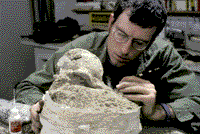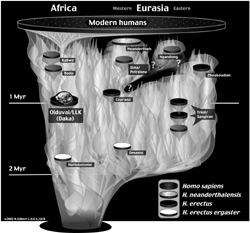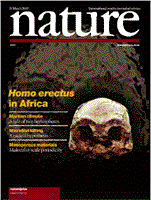Images & background information re Homo erectus find near Bouri, Ethiopia
Images
The following conditions apply to the use of each of the 3 copyrighted photographs:
1. The copyright protection notice must appear adjacent to each photo used. The credits to be used are shown in the captions.
2. These pictures are for your news organization's use only. Do not syndicate, sell or redistributed in any further way.
3. The pictures are available to appear as editorial content in print newspapers and their accompanying electronic form as current news only. An electronic version of these images shall not remain posted beyond April 21, 2002, without further permission. We do not permit the images to appear in any other media or form. Nor do we permit them to appear as part of a collection or review of news even if the product is an exact republication of the original print form published.
4. MAGAZINES OUT: Neither magazines, nor any other media are permitted to use these pictures without permission from David L. Brill: brill@mindspring.com.
5. Within these conditions the news release pictures are available to your organization at no charge until April 21, 2002.
6. Reproduction of the photographic images in part or in whole as a published piece or as individual images for promotion and or advertising is not granted.
7. No reproduction rights to these photos is transferred if any of these conditions is violated.
8. For further use of any of these still images or additional photography regarding this news release subject, please contact the photographer who specializes in human evolution subjects and is handling the photos for this project:
David L. Brill
552 Hwy. 279
Fairburn, GA 30213 USA
Tel & Fax: 770-461-5488
E-mail: brill@mindspring.com
 |
gilbert-skull..jpg 1.2M SITE: Bouri Daka Member, Middle Awash, Ethiopia VIEW: 3/4 view of BOU-VP-2/66 Daka calvaria SUBJECT: Henry Gilbert, a Ph.D. Candidate at the University of California at Berkeley, discovered this Homo erectus skull in December, 1997. With a porcupine quill, and other tools intended not to scratch the fossil, he is carefully removing the silty matrix that entombed the specimen for a million years. The newly discovered Homo erectus calvaria and its surrounding sediment was encased in a plaster "jacket" to enable safe transportation from the Afar desert in the East African Rift System to the National Museum of Ethiopia laboratory in Addis Ababa. At the time of this picture, the upper half of that jacket had been removed for Gilbert to continue the excavation in the Addis Ababa lab. The roof of the specimen's right eye socket is visible at this stage of the preparation. The face was presumably chewed away by a large carnivore prior to burial and is missing. However, the most important diagnostic features are still present on the specimen to show that a single species of hominid, Homo erectus, extended from Europe to Africa to Asia one million years ago. LOCATION: Paleoanthropology Laboratory, National Museum of Ethiopia, Addis Ababa, Ethiopia. COPYRIGHT PROTECTION NOTICE: Photo (c) David L. Brill \ Brill Atlanta |
 |
skull.jpg (1.2 M) SITE: Bouri Daka Member, Middle Awash, Ethiopia. VIEW: Frontal view of BOU-VP-2/66 Daka calvaria. SUBJECT: Henry Gilbert, a Ph.D. Candidate at the University of California at Berkeley, brushes away silty matrix from the Daka Homo erectus calvaria. The skull's surface was covered by a encrustation of fossilized rootcasts. These were carefully removed with an electric scribe before anatomical study could commence. LOCATION: Paleoanthropology Laboratory, National Museum of Ethiopia, Addis Ababa. COPYRIGHT PROTECTION NOTICE: Photo (c) Tim D. White \ Brill Atlanta |
 |
asfaw-gilbert.jpg (1.2M) SITE: Bouri Daka Member, Middle Awash, Ethiopia. VIEW: Laboratory comparative analysis in progress. SUBJECT: Because of differences in skull anatomy, some scientists had divided early Homo fossils into two separate species between 1.5 and 0.5 million years. The differences between Asian and African fossils were deemed so great that they would not have been able to interbreed to produce viable offspring. Here, Dr. Berhane Asfaw and Henry Gilbert compare the newly discovered Daka Homo erectus with the Asian and African specimens. The newly discovered specimen is so similar to the Asian fossils that the scientists concluded that these early hominids constituted a widespread single species that ranged from Java to Italy to Ethiopia a million years ago. Asfaw is holding the original Daka fossil with it's base toward the photographer, and is pointing to its massive browridges. Gilbert is holding a cast of a "Peking man" fossil from China in his right hand and a cast of an earlier Kenyan representative of Homo erectus in his left hand. Asfaw is pointing out the massive browridges, one of the many features shared by the newly discovered Ethiopian specimen and the Chinese and Indonesian representatives of Homo erectus. These anatomical similarities bridge the continental gaps and unify the species. LOCATION: Paleoanthropology Laboratory, National Museum of Ethiopia, Addis Ababa. COPYRIGHT PROTECTION NOTICE: Photo (c) David L. Brill \ Brill Atlanta |
 |
The diagram below has no restrictions on its use: Herectus.tif 339K The diagram shows the inferred relationships between the new Ethiopian fossil hominids from Daka and other sets of fossils across the Old World. The circles indicate "paleo-demes" for which fossil evidence has been recovered. Demes are local populations within a species. CREDIT: Henry Gilbert/UC Berkeley |
 |
Cover of March 21, 2002 Nature magazine (832K PDF file) Nature cover with photo of Homo erectus skull from Bouri, Ethiopia COPYRIGHT PROTECTION NOTICE: Photo (c) David L. Brill \ Brill Atlanta, Cover courtesy of Nature |